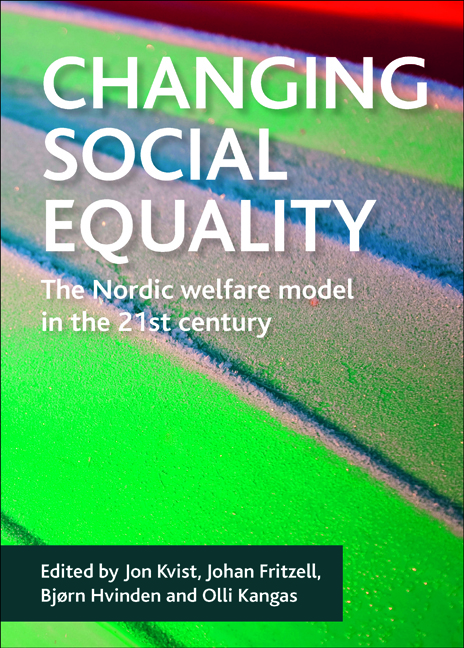Book contents
- Frontmatter
- Contents
- List of tables and figures
- Notes on contributors
- Acknowledgements
- one Changing social inequality and the Nordic welfare model
- two Anti-immigration attitudes, support for redistribution and party choice in Europe
- three Do we all (dis)like the same welfare state? Configurations of public support for the welfare state in comparative perspective
- four Eroding minimum income protection in the Nordic countries? Reassessing the Nordic model of social assistance
- five Equality in the social service state: Nordic childcare models in comparative perspective
- six Welfare state institutions, unemployment and poverty: comparative analysis of unemployment benefits and labour market participation in 15 European Union countries
- seven Social inequalities in health: the Nordic welfare state in a comparative context
- eight Income inequality and poverty: do the Nordic countries still constitute a family of their own?
- nine Is immigration challenging the economic sustainability of the Nordic welfare model?
- ten Nordic responses to rising inequalities: still pursuing a distinct path or joining the rest?
- Index
six - Welfare state institutions, unemployment and poverty: comparative analysis of unemployment benefits and labour market participation in 15 European Union countries
Published online by Cambridge University Press: 01 September 2022
- Frontmatter
- Contents
- List of tables and figures
- Notes on contributors
- Acknowledgements
- one Changing social inequality and the Nordic welfare model
- two Anti-immigration attitudes, support for redistribution and party choice in Europe
- three Do we all (dis)like the same welfare state? Configurations of public support for the welfare state in comparative perspective
- four Eroding minimum income protection in the Nordic countries? Reassessing the Nordic model of social assistance
- five Equality in the social service state: Nordic childcare models in comparative perspective
- six Welfare state institutions, unemployment and poverty: comparative analysis of unemployment benefits and labour market participation in 15 European Union countries
- seven Social inequalities in health: the Nordic welfare state in a comparative context
- eight Income inequality and poverty: do the Nordic countries still constitute a family of their own?
- nine Is immigration challenging the economic sustainability of the Nordic welfare model?
- ten Nordic responses to rising inequalities: still pursuing a distinct path or joining the rest?
- Index
Summary
Introduction
Much intellectual effort has been expended on debating welfare state regimes – whether they exist (and, if so, how many), what their central characteristics are and whether they are becoming more similar or not. In his Three worlds of welfare capitalism, which launched an avalanche of welfare regime studies, Gøsta Esping- Andersen (1990) emphasised that a welfare state regime consists of a multifaceted interplay between labour markets and social policies. From this perspective he distinguished three clusters of welfare state: Nordic, Liberal and Corporatist regimes. The hallmark of the Nordic welfare state, consisting of Denmark, Finland, Norway and Sweden, is a high level of employment, with high income protection when one is unemployed, sick, disabled, elderly, etc. As a consequence of these interacting factors, poverty rates in all population categories – the employed, the unemployed, the retired, etc – are low.
In the Liberal welfare state means-tested or low flat-rate benefits dominate and, as a consequence of the low level of social protection, poverty among the welfare recipients is common. Typical examples of this welfare state model are: Australia, Canada, Ireland, New Zealand, the UK and the US. The third cluster, the Corporatist – typical of the Central European countries Austria, France, Germany, Belgium and the Netherlands – combines high social insurance benefits for the labour market insiders and a strong degree of familialism that supports traditional gender roles. To preserve class and status difference, social security is organised according to occupational lines. Esping-Andersen's triad has been expanded to include a fourth model, the Southern European welfare state (Greece, Italy, Portugal and Spain), characterised by generous entitlements for the core workers – the replacement rates are among the highest in the EU hemisphere – while other forms of social protection are underdeveloped and the extended family plays a central role in care-giving. Female labour force participation is thus very low in comparison to the other regimes (Ferrera, 2010).
This chapter examines the interaction between the labour market, employment and social security in different welfare state regimes. More specifically, we investigate to what extent, if any, we can find regime-based differences in labour markets, in the generosity of unemployment insurance or in the economic consequences of being employed, becoming unemployed for a shorter or longer period and becoming employed again. Our study spans the mid-1990s to the late 2000s.
- Type
- Chapter
- Information
- Changing Social EqualityThe Nordic Welfare Model in the 21st Century, pp. 119 - 142Publisher: Bristol University PressPrint publication year: 2011



